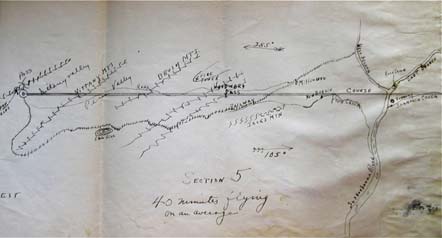

Since September 8, 1920, the service had flown the mail from New York to San Francisco during daytime only, transferring it to trains at night. Air Mail Service pilots flying wire-braced, open-cockpit biplanes established a pattern that evolved into the present global air transportation network. Nineteen ninety-six marked the 75th anniversary of that aviation milestone, the first time in history that airmail was carried between points at an announced time, irrespective of weather or time of day. transcontinental flight, the world's first scheduled long distance flight - New York to San Francisco. Photo courtesy of the United States Postal Service. One incident, which made world news, occurred on the first day of the first day/night transcontinental. Leonhardt's DH-4B number 157 had force-landed four times. PHOTO: By the time this photo was taken at the Omaha, Nebraska, airmail field in 1921, Elmer G. Little lifted their de Havillands from San Francisco heading east toward the sun, much of their commemorative airmail addressed to New York. Air Mail Service pilots Farr Nutter and Raymond J.

Leonhardt also had taken off from the same field.

The place, Hazelhurst Field, Mineola, Long Island, and the date, February 22, l921. His tail skid lifted, and in a moment pilot and biplane, carrying 350 pounds of mail bound first for Cleveland then for points west, as far as San Francisco, disappeared into the early morning gloom. Turning into the wind, he opened the throttle fully, and skimmed along the runway. Waving a cheerful farewell to well-wishers, he taxied across the airfield. Smoke swirled from the World War I surplus bomber's exhaust, enveloping bystanders in a cloud of noxious fumes. He signaled his mechanics to pull the chocks from under his wheels, then he eased open the throttle on the de Havilland-4B (DH-4B), sending it surging to life. Allison lowered his aviator's goggles and fastened his sheepskin-lined helmet. Allison, unsung hero of the first day/night transcontinental, smiles proudly from his personalized de Havilland-4B.ĭirty gray clouds rolled in low over Long Island Sound, a sure sign of bad weather ahead. Navigating the First Day/Night Transcontinental


 0 kommentar(er)
0 kommentar(er)
